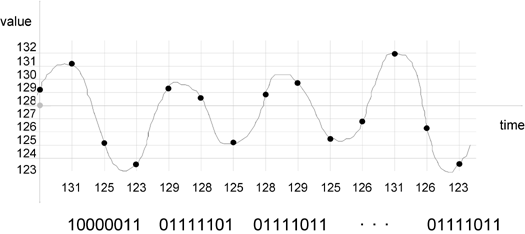Teracom Tutorial: Voice Digitization Standard: DS0


There are three steps in voice digitization: quantization, sampling and coding.
The telephone system quantizes the voice signal to 256 levels. This number is chosen to reduce the quantization error, which would be heard as noise after the signal is reconstructed, so that a person can’t hear it on the line. The diagram shows bin numbers 127 and 128 around zero volts.
The second step is sampling. Since this is a voiceband signal, the frequency bandwidth is about 3000 Hz, and so the sampling rate must be at least 6001 times per second, following the Dr. Nyquist’s sampling theorem. To ensure that there are no aliasing errors, the telephone system samples more often: 8,000 samples per second.
The third step is coding. The telephone system uses 8 bits to code the value of each sample. This technique of using 8 bits per sample is called by some Pulse Code Modulation (PCM), which doesn’t really mean anything. To determine the number of bits per second required, multiply the number of samples per second (8,000) by the number of bits per sample (8) to get 64,000 bits per second, or 64 kb/s for short.
This 64 kb/s rate is called a DS0 rate signal (Digital service level zero, or digital signal rate zero, just called “DS0s” in the business). This is the base rate of most transmission systems and digital voice systems. When someone talks about a channel on a digital transmission system, they usually mean a DS0.
Commercial transmission systems which are actually deployed were designed to carry digitized voice, and thus move multiple DS0s. Since they are digital systems, they can be easily be adapted to carry data or video as well as digitized voice.
The bottom line: we move a byte (representing the value of the sample) 8,000 times per second from one end to the other, for each voice.